The U.S. Introduces a New Trilateral Alliance with South Korea and Japan that Could Keep US Troops in Asia Forever
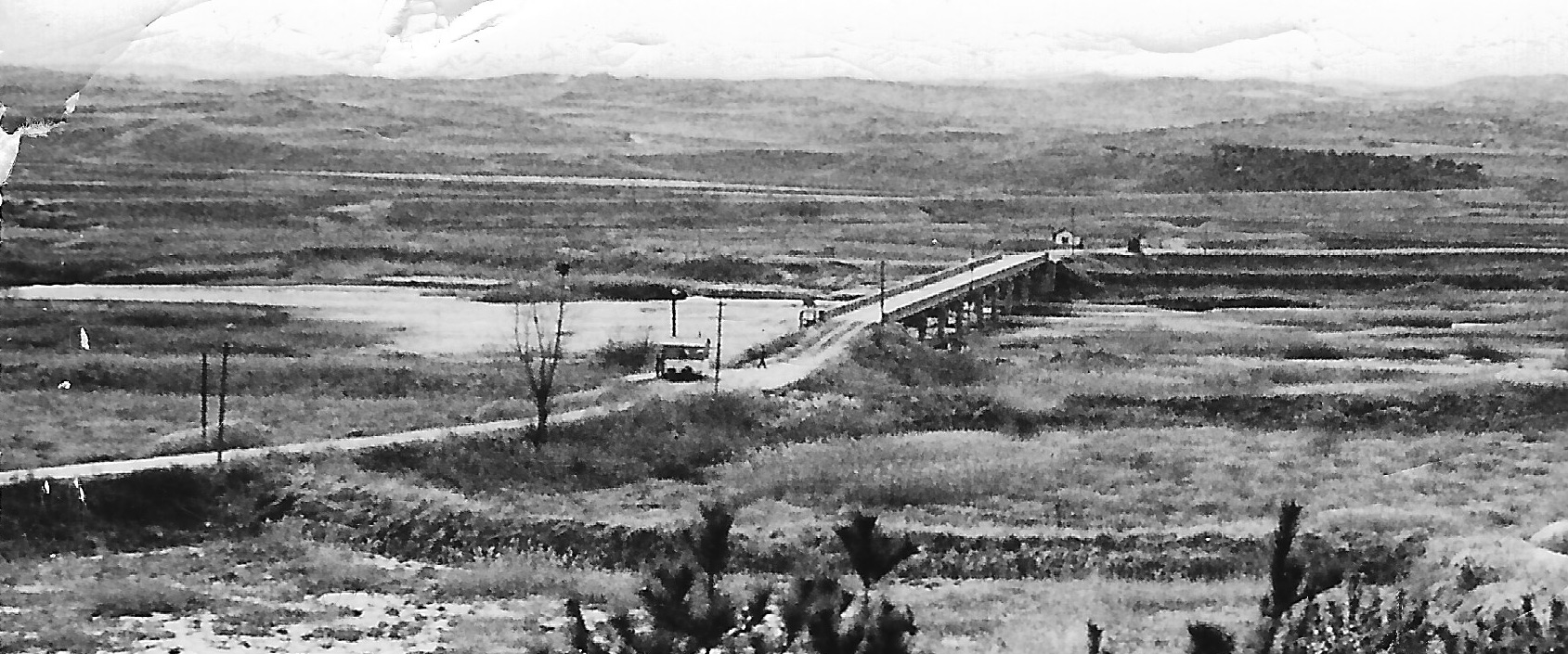
WASHINGTON – On July 27th, the United States and South Korea will mark the 70th anniversary of the armistice in Panmunjom that ended combat in the Korean War and created the bilateral security arrangement that keeps 28,500 U.S. soldiers in Korea today. But if that armistice was designed to bring peace to the Korean Peninsula and the surrounding Asia region, it has failed miserably.
Korea remains bitterly divided and in a continual state of technical war. Tensions between the combined forces of the United States and South Korea and nuclear-armed North Korea are as high as they have ever been, with nearly every day bringing another tit-for-tat military escalation. Meanwhile, military maneuvers, some involving China and Russia, have turned the seas and skies around the Korean Peninsula into one of the most dangerous spots in the world.
“The intensity of nuclear threats that the US and North Korea are trading has reached an extreme, surpassing even the levels of 1994 and 2017, when the Korean Peninsula was pushed to the brink of war,” the progressive daily Hankyoreh declared in its lead story on July 25. At the DMZ, “Millions of troops on both sides stand ready to plunge back into battle at a moment’s notice,” the New York Times noted in a massive photo presentation on life at the Korean border.
That is hardly a record to boast about as we observe the past 70 years of American policy in Korea and Northeast Asia.
The latest confrontation between the U.S. and North Korea occured last week, when the Pentagon dispatched the USS Kentucky, an Ohio-class nuclear submarine equipped with ballistic and cruise missiles mounted with nuclear warheads, to a South Korean port for the first time since 1981. On Monday, it sent another nuclear submarine, the Los Angeles-class USS Annapolis, to dock at the South Korean naval base on Jeju Island. It is equipped with Tomahawk long-range cruise missiles and no nukes, but the U.S. and South Korean message from these visits was unmistakable.
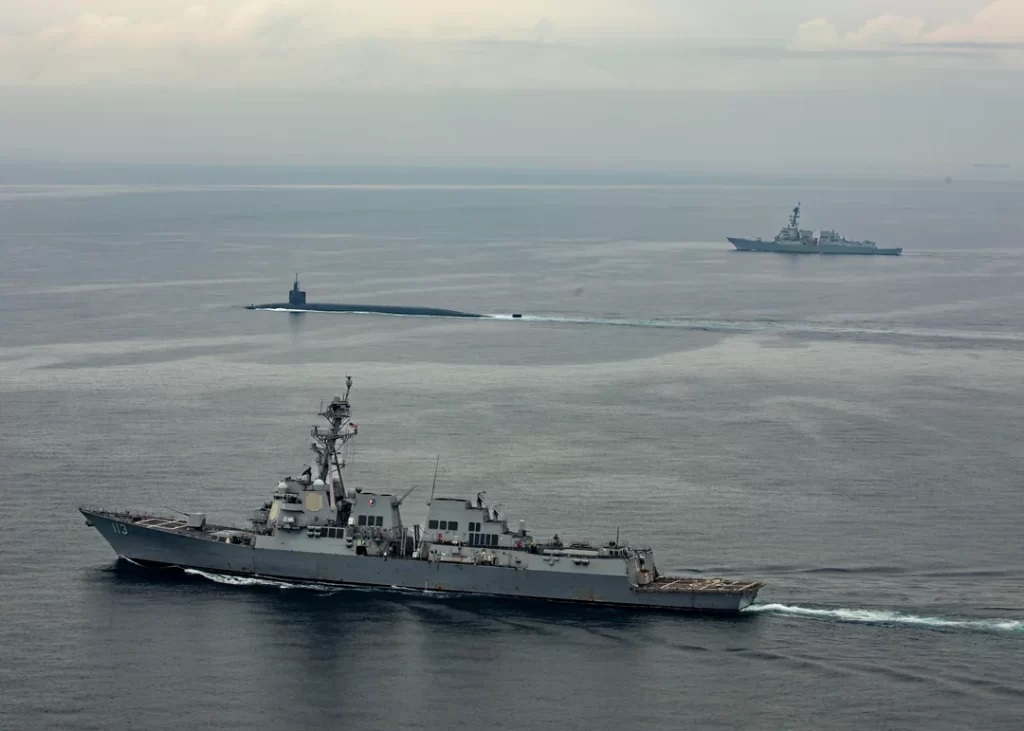
While the Kentucky was in Busan, President Yoon Suk-yeol paid a personal visit to the submarine and warned that any nuclear provocations by North Korea could “lead to the end of its regime.” In response, Kim Jong Un’s military – as it has been doing all year – launched two short-range ballistic missiles into the East Sea. It also issued a blunt warning about the US deployment of nuclear-armed submarines, saying it “may fall under the conditions of the use of nuclear weapons” specified in DPRK military doctrine.
A week earlier, Kim Yo-jong, Kim’s powerful sister-aide, condemned “eight straight days” of US Air Force reconnaissance aircraft conducting “provocative aerial espionage” near her country’s borders. “There is no guarantee” such aircraft will not be shot down in the future, Pyongyang’s defense ministry added – an ominous reminder of its 1969 shoot-down of a U.S. Navy EC-121 spy plane.
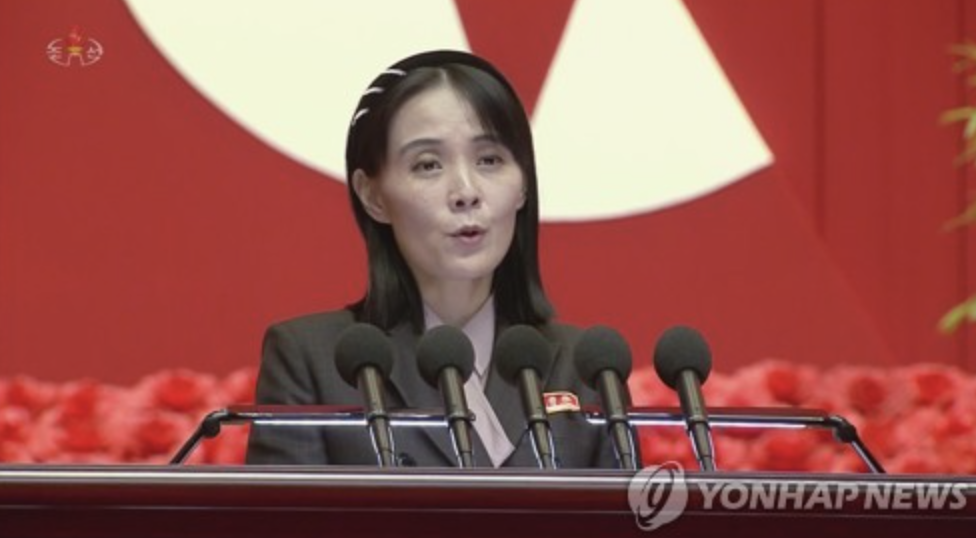
Outside of Korea, meanwhile, American political and military leaders are talking openly about the inevitability of full-scale war with China, North Korea’s closest ally. That possibility, along with threats to use U.S. atomic weapons in Korea, drove Presidents Truman and Eisenhower to the bargaining table at Panmunjom in the 1950s. Despite Secretary of State Tony Blinken’s recent opening of a dialogue with Beijing, however, leaders of both political parties seem intent on exacerbating the conflicts with China, with no end in sight.
But rather than using the 70th anniversary of the armistice to honor the dead and find a way to make a permanent peace among the still-warring parties, President Biden and his national security team are touting the virtues of a three-pronged military alliance between the United States, South Korea, and Japan as the most effective way to confront North Korea. As envisioned by U.S. leaders, this alliance could keep the forever war in Korea going for another 70 years and even longer.
Few Americans are aware of these proposals. But they will be soon.
On August 18th, President Biden will welcome President Yoon and Japanese Prime Minister Fumio Kishida to his presidential retreat at Camp David for their first-ever meeting alone. The three leaders have met before to talk about common interests, but only on the sidelines of multilateral events where other countries were present. Camp David will thus mark “the first time the three countries’ leaders will be meeting separately for the purpose of holding a trilateral summit,” Korea’s JoongAng Daily reported from Seoul.
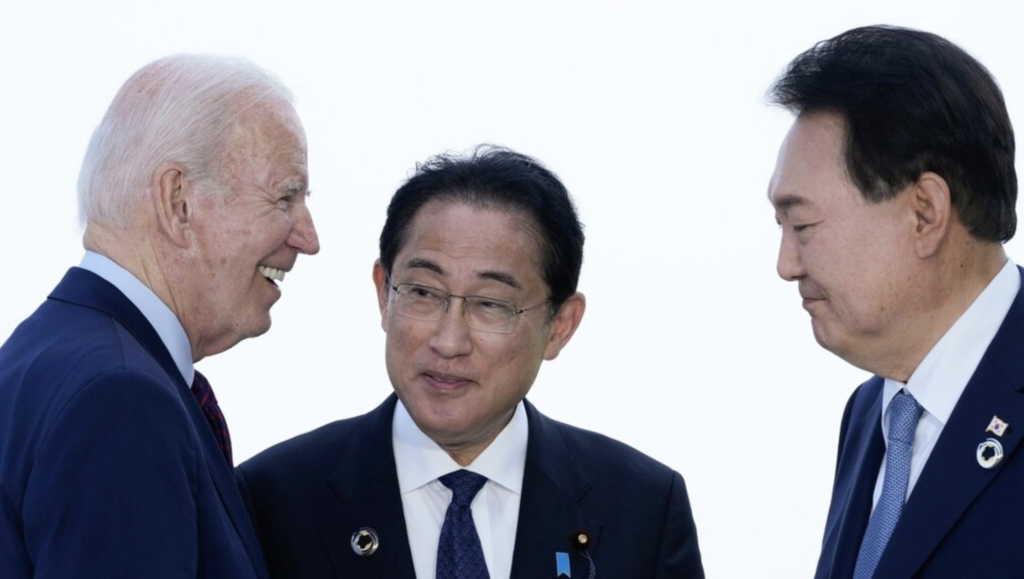
From my perspective of 45 years of reporting on the U.S. role in Korea and Japan, this is a major development.
The idea of an alliance linking the United States and South Korea with Korea’s former colonizer would have been unthinkable at the time of the Korean War, when memories still burned of Japan’s brutal colonial rule. Because of these political barriers, President Biden and the Washington neocons who back a tough U.S. stance in Asia have explained the budding alliance as a unified, eleventh-hour response by Tokyo and Seoul to China’s emergence as a military and economic power in the Pacific and a smart way to contain North Korea and its nuclear ambitions.
In truth, as I have found in research in the National Archives, Washington has been encouraging Japanese rearmament and the merging of Japanese and Korean strategic interests since the first years of the U.S. military occupation of Southern Korea (which lasted from 1945 to 1948, when the Republic of Korea was created as a separate state). US officials began seriously pressing for Japanese involvement in Korea during the Vietnam War, particularly after South Korea and Japan – under intense US pressure – signed a 1965 treaty normalizing their ties for the first time since World War II.
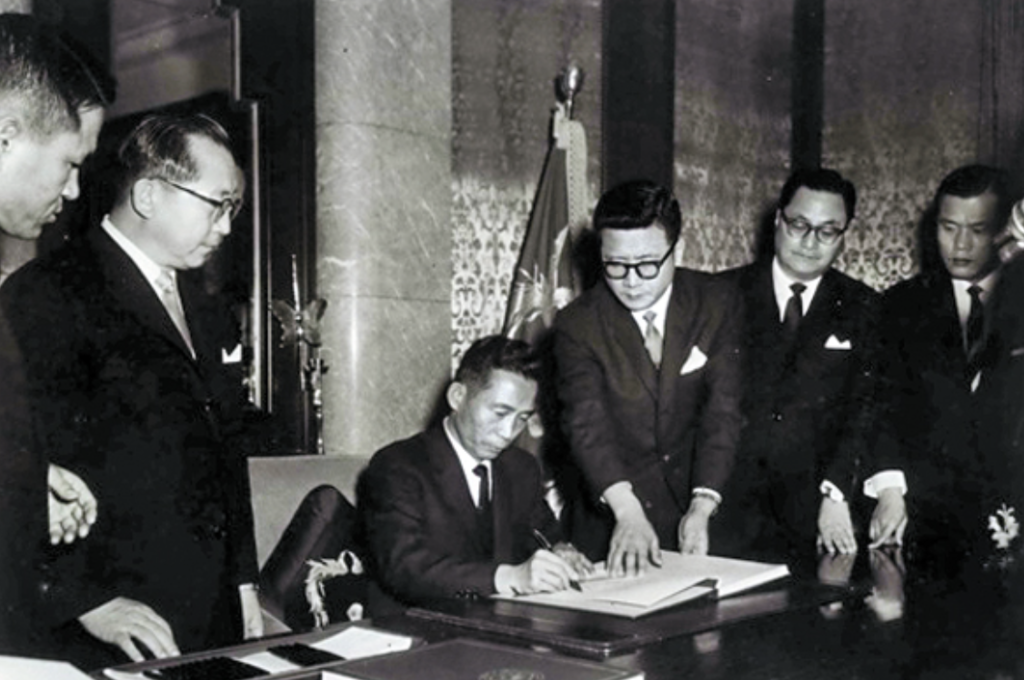
During the Obama administration, U.S. officials tried hard to create an alliance with Tokyo and Seoul by encouraging the two countries to end their long-running dispute over Imperial Japan’s cruel exploitation of Korean sex slaves known as “comfort women.”
But during the presidency of Moon Jae-in, a former dissident who championed engagement with North Korea over military confrontation, the idea was flatly rejected. Relations deteriorated after Japan’s Abe government imposed export controls in South Korea in retaliation for a court decision that allowed Korean citizens to sue Japanese corporations for using Korean forced labor during World War II. In retaliation, Moon’s government suspended its military intelligence sharing arrangements with Japan.
All that changed when Biden came to office in 2021 and Yoon, a right-wing militarist sympathetic to Japan, was elected to succeed Moon as president in 2022. Both leaders rejected Moon’s engagement policies, and for reasons of their own have embraced the idea of Japan playing a much greater role in military operations. The first signs of a renewed alliance emerged in October 2022, when three countries restarted trilateral military exercises that ceased in 2017 with a series of missile defense drills by their respective navies. Yoon also restored the intelligence-sharing.
As they unfolded, the Pentagon called the trilateral drills a symbolic move towards “the interoperability of our collective forces,” while the conservative Japan Times noted they pushed “trilateral security ties closer than ever.” “We’re never satisfied until every operation is a partnered operation all the time,” Admiral Samuel Paparo, Commander of the U.S. Pacific Fleet, told reporters.
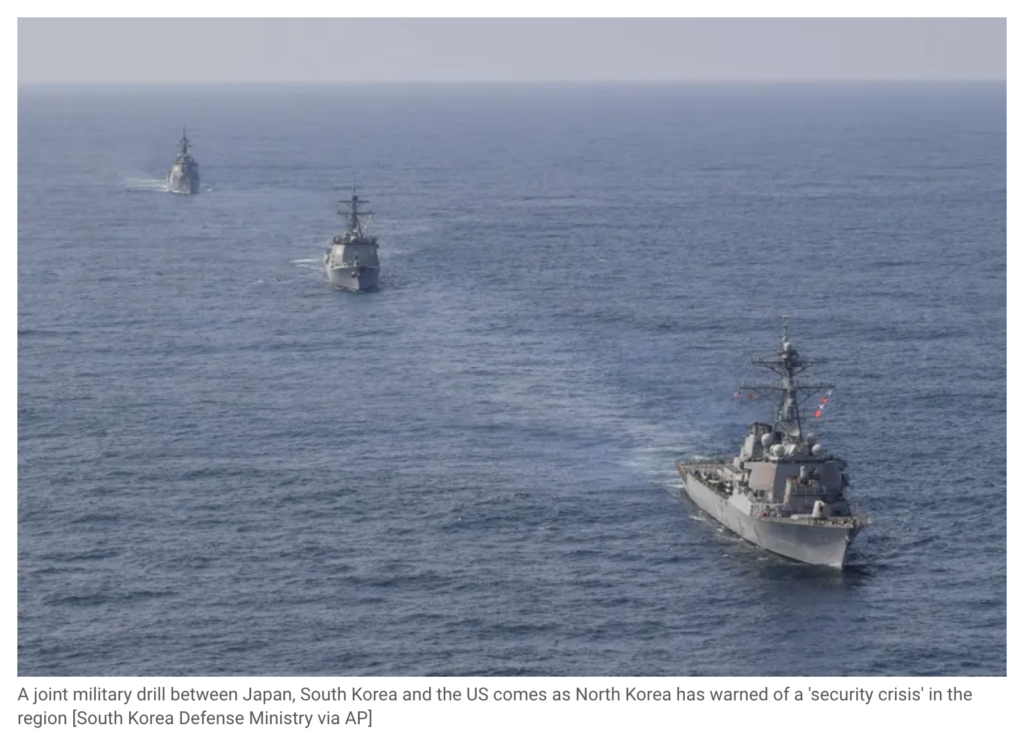
But the drills, particularly South Korea’s sharing of intelligence data during the exercise, triggered a sharp attack from Pyongyang. “The U.S. and its followers will get more and more exposed to security crisis facilitating its final ruin for its frantic moves to tighten their military alliance against the DPRK and expand the war drills for aggression,” Kang Jin-song, an international affairs analyst, said in an article released by the North’s Korean Central News Agency.
Despite the recognition of the alliance by North Korea and many in the media, the US-ROK-Japan alliance has not been explained well to the American people. Moreover, the very idea of a trilateral alliance, particularly one aimed at containing China, is rejected as unrealistic and inaccurate by some U.S. foreign policy experts, including liberals and leftists who see Japan and South Korea as autonomous players within the larger U.S. alliance framework in Asia (when I pitched a shorter version of this piece to one publication, the editor urged me to refrain from even using the term “trilateral alliance. I declined).
That reluctance is a mistake. The evidence for a US-led military alliance linking the Kishida government in Japan and the Yoon government in South Korea is as plain as day.
The foundation for the alliance was laid in Tokyo last March in a critical summit meeting between Yoon and Kishida. They reached an agreement to resolve the Korean claims that Japanese corporations exploited forced labor from Korea during World War II, thus clearing the way for “a tripartite alliance to meet security challenges in Asia,” NPR reported. Under its terms, Japanese corporations will pay no indemnities; instead, the costs to victims are being borne entirely by South Korea.
The agreement was hailed by the Biden administration and pundits who support his hawkish policies in Asia as a masterpiece of diplomacy, and Yoon was rewarded with a rare state visit to the White House. During a joint press conference, Biden made clear that Yoon’s concessions had made possible a three-way relationship.
“The Republic of Korea and the United States are working together, including through our trilateral cooperation with Japan, to ensure the future of the Indo-Pacific is free, is open, prosperous, and secure,” he said. “I want to thank you again, Mr. President, for your political courage and personal commitment to diplomacy with Japan.”
A few weeks later, Biden met with Yoon and Kishida on the sidelines of the Group of 7 summit in Hiroshima. The US president again “commended” the two leaders “on their courageous work to improve their bilateral ties” and said the new trilateral relationship would be a critical element in his “Indo-Pacific” strategy.
The other important piece to the trilateral military alliance was Kishida’s decision to raise Japan’s military budget to record levels.
Under Japan’s latest plans, as described by the Associated Press and the Asahi, Japan has made the initial installment of a five-year, $315 billion military spending plan. If it meets this target, Japanese military spending will meet NATO standards and “eventually push its annual defense budget to nearly $73 billion – the world’s third biggest after the United States and China.”
Moreover, in what I’ve described as a “crossing the Rubicon” moment, the LDP government has embraced a new counterstrike capability allowing its self-defense forces to undertake offensive actions for the first time since World War II.
Although not stated publicly, Japan’s new policies are well understood by US planners as indicating its willingness to send Japanese troops to Korea in the case of a “collapse” of the North Korean regime. As I pointed out before Biden took office, ODNI director Avril Haines suggested in 2017 that this possibility should be part of US “intensive contingency planning” for North Korea that “must be done” with South Korea and “of course Japan.”
Led by Campbell, Author of the “Asia Pivot,” Biden Aides Smooth the Way
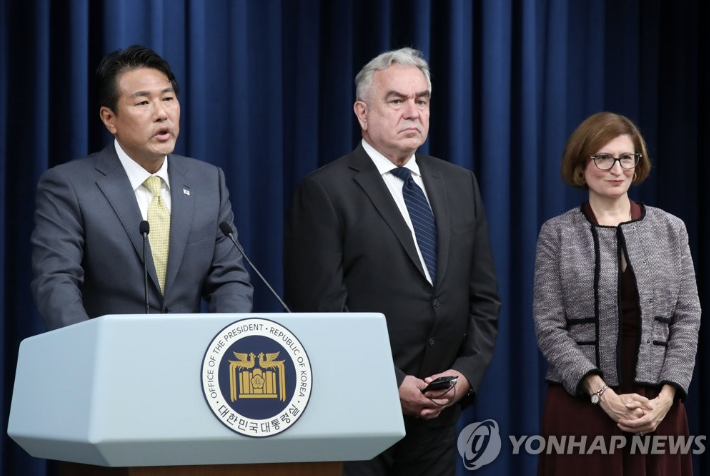
Last week, as the 70th anniversary of the war approached, Biden’s national security team visited both countries to emphasize the progress they have made on the alliance. Like many American interactions with its Asian allies, these encounters have resembled family therapy where parents soothe their squabbling children and reward them for making up.
Playing the the role of Big Daddy is Kurt Campbell, Biden’s “Asia Czar,” or Indo-Pacific Coordinator at the National Security Council. A diplomat with close ties to military think tanks such as the Center for Strategic and International Affairs, Campbell served President Obama as his top US diplomat for Asia and the Pacific.
He’s most famous for inventing the term “Asia Pivot, in which Obama and the Pentagon began shifting US forces from Afghanistan and the Middle East back to Asia as part of their refocus on China and North Korea. His role in the trilateral mechanism has been crucial. As I noted in a comprehensive piece on Biden’s potential Asia policies in 2021:
With Tony Blinken and Avril Haines – now, respectively, Biden’s secretary of state and director of national intelligence – Campbell played a key role in the Obama administration’s attempt to stop North Korea’s nuclear programs with a combination of military pressure, secret cyber-attacks, and sustained economic sanctions. Campbell is also known as one of the most pro-Japan officials in government.
He is a key figure in a policy faction that sees Japan and its right-wing ruling Liberal Democratic Party as the linchpin of the US alliance system in the Asia region. Like many officials and think tank “experts,” he views South Korea as a subordinate partner to US and Japanese efforts to force North Korea to give up its nuclear weapons and contain the growing military power of China.
On July 12, Campbell met in Washington with a group of lawmakers from Yoon’s right-wing People Power Party and strongly praised Yoon for showing “courageous leadership” in dealing with Japan, adding that “President Biden is also pleased with that,” according to state-owned Yonhap News. Two days later, on July 14th, he was in Seoul to co-chair the first meeting of the US-South Korea “Nuclear Consultative Group” overseeing the deployment of US strategic assets to Korea, as discussed by Biden and Yoon at their meeting at the White House last April.
“As we speak an American nuclear submarine is making port in Busan today,” Campbell announced. “It’s the first visit of an American nuclear submarine in decades.” Even as a U.S. soldier apparently defected across the DMZ to North Korea that day, the US media failed to note the extraordinary sight of a low-level American official taking it upon himself to announce a momentous shift in policy towards Korea.
That same day, Secretary of State Tony Blinken – who worked closely with Campbell as Obama’s deputy national security adviser – was in Indonesia for a multilateral forum on regional security. There, he met with Japanese Foreign Minister Hayashi Yoshimasa and the ROK’s Park Jin and “commended them ‘on recent progress in strengthening Japan-ROK ties and stressed the important of trilateral cooperation in tackling regional and global issues.'”
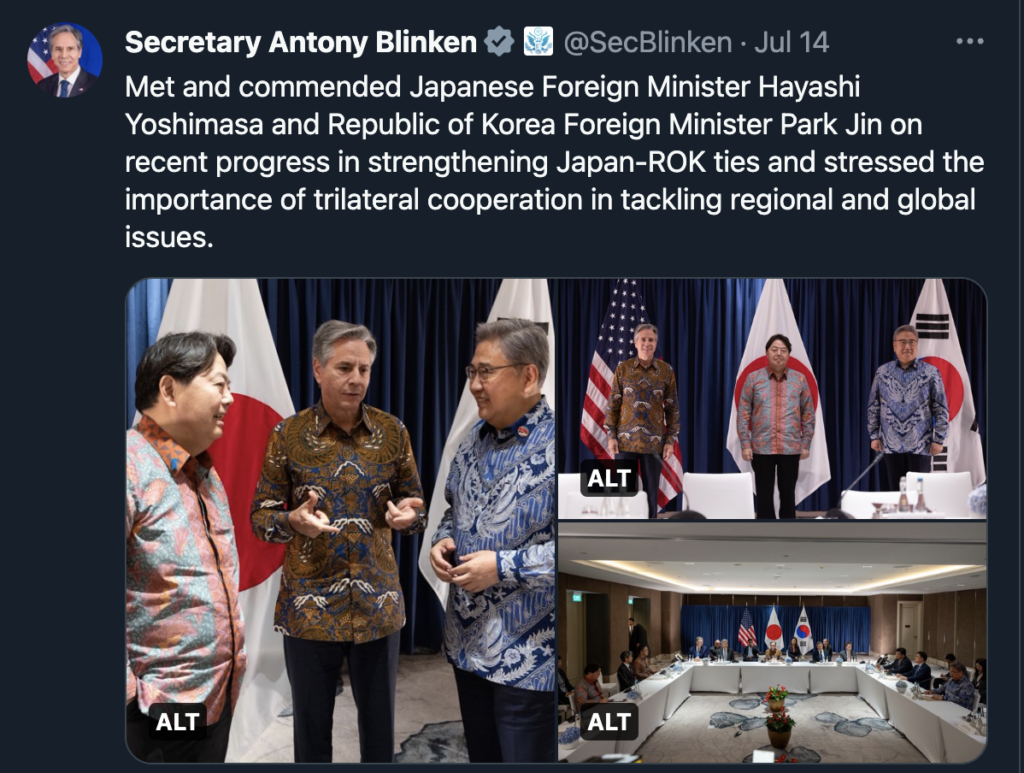
The Pentagon got into the act in early June, when Secretary of Defense Lloyd J. Austin “convened a trilateral ministerial meeting” in Singapore with Japanese Minister of Defense Hamada Yasukazu, and ROK Minister of National Defense Lee Jong-Sup. Their joint press statement committed the three sides to “concerted trilateral cooperation” and “enhanced trilateral security exercises” and welcomed President Yoon’s normalization of the “U.S.-Japan-ROK Trilateral Information Sharing Arrangement to facilitate coordination and cooperation among all three sides.”
General Mark A. Milley, the chairman of the Joint Chiefs of Staff, delivered a similar message on July 11th in a “Trilateral Chiefs of Defense Meeting” (the Pentagon’s headline) with his equivalents in Tokyo and Seoul. The three military officers agreed “to develop bilateral and trilateral response options” to Korean security and stated that “the US-Japan and US-ROK Alliances are essential to maintaining regional peace and stability.”
Milley then flew to Tokyo, where he commended “Japan’s commitment to doubling its defense spending over the next five years.” In other comments, America’s top general mentioned “Japan’s need for improvements in cruise missile defense, early warning missile systems and air capabilities, all of which would help the United States as it looks to counter North Korea’s push for a nuclear missile program.”
China figures in as well. Beijing, said Milley, has “invested enormously in their military and aspire to be the regional power in the next 10 to 15 years.” That “could be very unstable; it could be very dangerous, and I think having a powerful Japan, a militarily capable Japan that has a close alliance with the United States and other countries, will go a long way to deterring war…I have no doubt that the Japanese military could rapidly expand in scale, size, scope and skill very, very fast.”
Biden, South Korea, and Japan: A Jarring Disconnect
Despite these public pledges for a trilateral alliance, there is a huge and jarring disconnect between U.S. policy makers and the people of Korea and Japan. That was clear to my during my recent swing through Japan and South Korea.
In Korea, the Yoon-Kishida agreement on forced labor has been widely denounced as a sellout. Yoon, a right-wing militarist who once was the country’s chief prosecutor, was already disliked because of his government’s incompetence and his crackdown on the Korean labor movement, which he has accused of North Korean sympathies. Now, many Koreans are appalled at his one-sided pact with Japan and his praise for Kishida and the Liberal Democratic Party, which has been one of the most consistent denialists of Japanese war crimes.
This has cost the United States important support in a country where a majority of people support the presence of U.S. troops. As recently as the 1990s, U.S. forces were hated by much of the population because of a system of military prostitution and a series of violent attacks on Korean women by American GIs in the bases near the DMZ. The animosity has ebbed in recent years, particularly after U.S. Forces Korea consolidated nearly all its bases in Korea at Camp Humphreys in Pyongtaek, 80 miles south of Seoul, where for the most part U.S. soldiers are out of sight, out of mind. But that could change with Yoon’s embrace of Japan.
“After Yoon’s visit to Washington and the creation of the trilateral alliance with Japan, the Korean people may show in their own deep minds a sense of anti-Americanism,” Lee Boo Young, a prominent opposition activist from the 1980s, told me in Seoul. “U.S. policy makers may also drive Koreans to embrace their anti-Japanese feelings.” Lee, who once led anti-American demonstrations during the 1980s, is now the chairperson of a coalition called Urgent Action for Peace and Democracy in Korea.
The disconnect also large when it comes to Korea’s history with Japan.
In a jarring episode at the 60th anniversary of the armistice in 2013, President Obama delivered a militaristic speech at the Korean War Memorial in Washington and paid tribute to the “legendary General Paik Sun Yup,” who was in the audience that day. Paik was a U.S. favorite: he had commanded the famous ROK First Division in the early weeks of the Korean War and led the defense at the Naktong River when U.S. and Korean forces sheltered in the Busan Perimeter. Later, as the Northern forces fled north across the lines, he led Korean troops in the U.S.-led counterinsurgency campaign against communist fighters in the Jiri Mountains south of Seoul.

But Obama’s positive view of Paik is not shared in Korea, where he is despised – even by some in the government – for being as part of the Gando Special Forces, a notorious unit of the Japanese Imperial Army that hunted down Korean independence fighters in Manchuria in the 1930s and 1940s.
In 2009, under the conservative government of Lee Myung-bak, a presidential committee placed Paik’s name on a list of 705 prominent collaborators with the Japanese. And when Paik died in 2021, the Moon Jae-in government refused to allow his remains to be buried in the National Cemetery, citing his collaboration with Japan (in contrast, the U.S. military in Korea named a building after Paik at its headquarters at Camp Humphreys). In the latest development in this dispute, President Yoon’s veterans ministry this month deleted a state burial record describing Paik “as a pro-Japanese figure, saying that such an expression was written with no legal grounds.”
A similar phenomenon has played out with Prime Minister Kishida’s LDP predecessor, the late Shinzo Abe.
In 2022, Abe, Japan’s longest-serving prime minister, was assassinated with a firearm by a former member of Japan’s Self-Defense Forces. American politicians from every faction of the establishment – President Biden, Hillary Clinton, Donald Trump, and Mike Pompeo among them – took to social media to praise the former prime minister as a great statesman, humanitarian, and American ally.
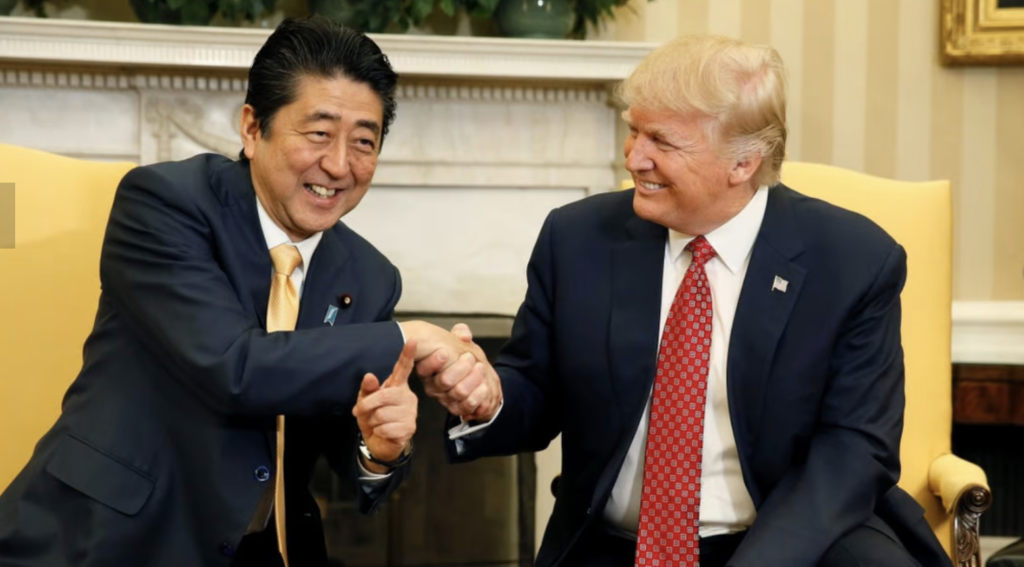
But most Japanese knew him as the grandson of the notorious Nobusuke Kishi, the former war criminal who, with US backing, was Japan’s Prime Minister from 1957 to 1960. Like Kishi, Abe was a prominent denialist of Japanese war crimes as well as a major supporter of the far-right Unification Church of South Korea’s Rev. Sun Myung Moon.
When the media revealed that the assassin shot Abe to avenge his mother, who was pressured to donate her family fortune of around $700,000 to the Unification Church, and more and more stories came out on Abe’s ties to the Moonies, the assassin became a folk hero to much of the public and a black mark on Abe’s dominant faction in the Liberal Democratic Party.
Finally, there is the issue of American military bases. It’s important for Americans to know that the enormous string of U.S. bases in Korea, Okinawa, and Japan will provide the firepower and soldiers in any future war with China or North Korea. But these bases are not always welcomed by the people who live there and are seen by many as dangerous threats to peace. This is particularly true in Okinawa, where 70 percent of U.S. bases in Japan are concentrated. There, citizens have voted time and time again to seek the removal of the U.S. Marines from their islands.
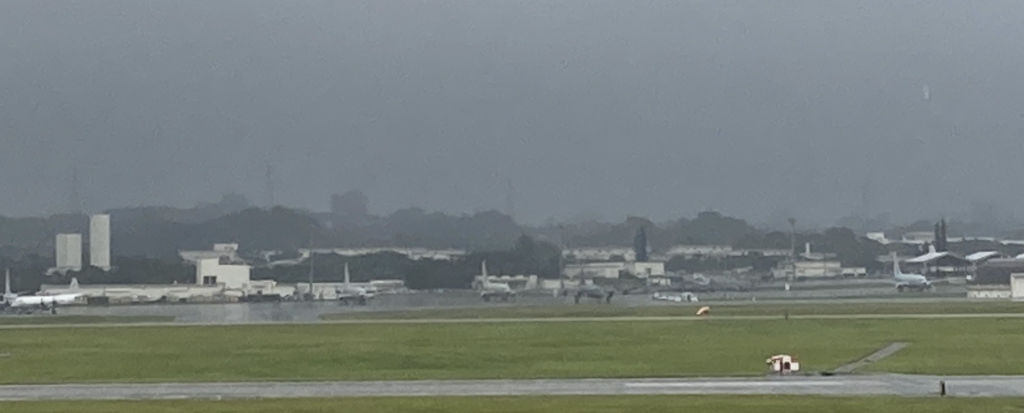
Their concerns were spelled out to me during my recent trip to Okinawa. One day in April, I visited the contested site at Henoko where the Japanese government is building a new air base for the U.S. Marine Corps. Afterwards, I sat down with Yoshimi Teruya, Okinawa’s vice governor and a leader of its independence movement, for an exclusive interview.
He told me that Americans must understand the huge and unnecessary burden of U.S. bases on his prefecture since the end of World War II. “American military forces came here 78 years ago and never left,” he said. “Are they going to stay here 100 years? There’s no country in the world where foreign troops have stayed for a century!”
That question, of course, could also be asked about the entire region, particularly South Korea. 70 years is a long time; will US forces be in Korea and Japan another century? If US policy continues like this, they could be.
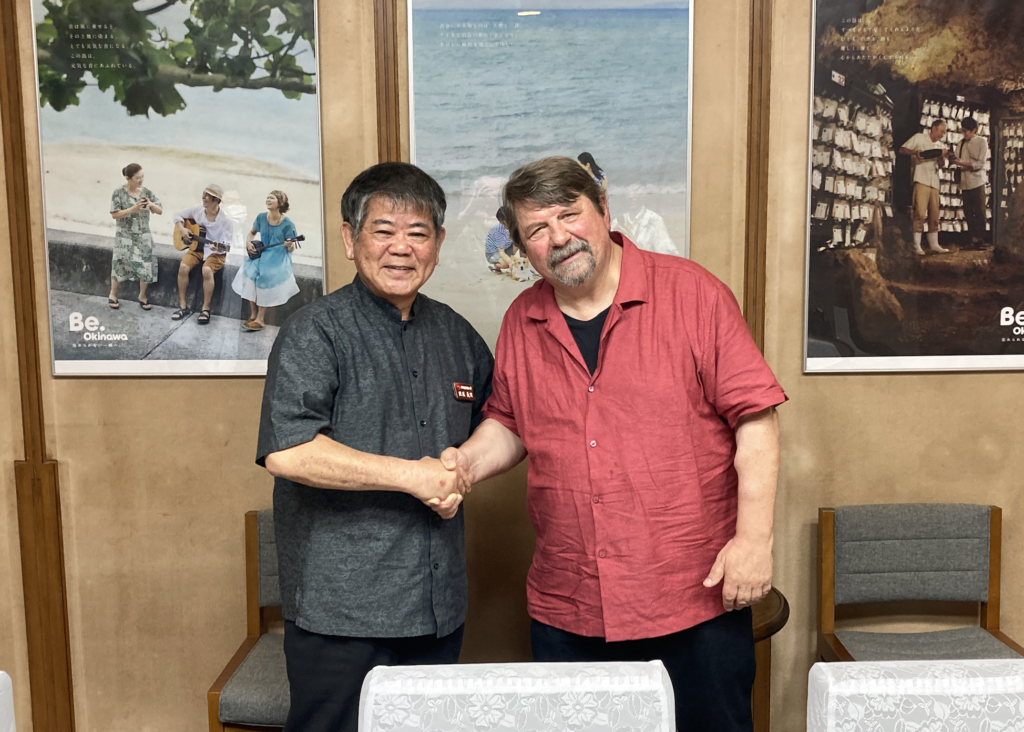
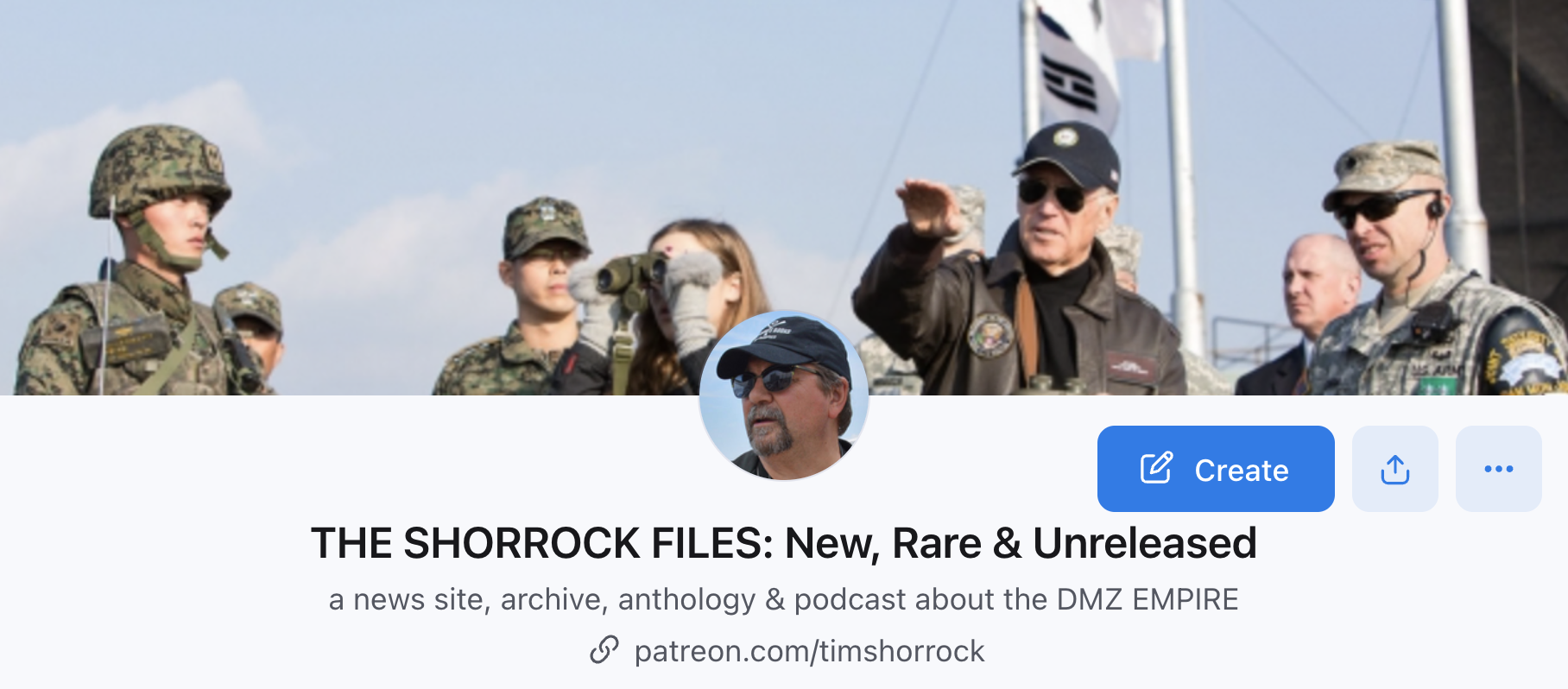
It breaks my heart to see the US escalating tensions in the Korean Peninsula. There have been so many chances at peace, and every time the US scuttles them. The fact that the ruling class of the US can’t see the folly in fighting a nuclear power terrifies me. The only peace I can find is that God blesses peacemakers and condemns war-makers.
As this short video explains “The Korean War May Never End” because American warmongers will not allow peace.
https://www.youtube.com/watch?v=mvsGbZt35XA